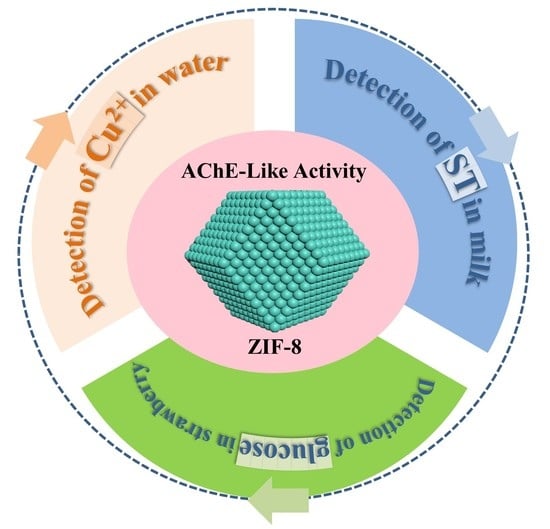A Sensitive and Selective Colorimetric Method Based on the Acetylcholinesterase-like Activity of Zeolitic Imidazolate Framework-8 and Its Applications
Abstract
1. Introduction
2. Results and Discussion
2.1. Characterization of ZIF-8 and Feasibility of the Method for Cu2+, ST, and Glucose Detection
2.2. Optimization of the Detection Conditions
2.3. Kinetics Study and Stability of ZIF-8
2.4. Colorimetric Detection of Cu2+, ST, and Glucose
2.5. Detection of Cu2+, ST, and Glucose in Real Samples
3. Materials and Methods
3.1. Chemicals and Materials
3.2. Instruments
3.3. Synthesis of ZIF-8
3.4. ZIF-8 Activity Assays
3.5. Enzyme Kinetics
3.6. Procedure for Cu2+, ST, and Glucose Determination
3.7. Real Sample Analysis
4. Conclusions
Supplementary Materials
Author Contributions
Funding
Institutional Review Board Statement
Informed Consent Statement
Data Availability Statement
Conflicts of Interest
Sample Availability
References
- Chen, W.; Vázquez-González, M.; Kozell, A.; Cecconello, A.; Willner, I. Cu2+-modified metal-organic framework nanoparticles: A peroxidase-mimicking nanoenzyme. Small 2018, 14, 1703149. [Google Scholar] [CrossRef] [PubMed]
- Dai, Z.; Liu, S.; Bao, J.; Ju, H. Nanostructured FeS as a mimic peroxidase for biocatalysis and biosensing. Chem.-Eur. J. 2009, 15, 4321–4326. [Google Scholar] [CrossRef] [PubMed]
- Zhang, D.; Han, Q.; Liu, W.; Xu, K.; Shao, M.; Li, Y.; Du, P.; Zhang, Z.; Liu, B.; Zhang, L.; et al. Au-decorated N-rich carbon dots as peroxidase mimics for the detection of acetylcholinesterase activity. ACS Appl. Nano Mater. 2022, 5, 1958–1965. [Google Scholar] [CrossRef]
- Niu, X.; Li, X.; Lyu, Z.; Pan, J.; Ding, S.; Ruan, X.; Zhu, W.; Du, D.; Lin, Y. Metal-organic framework based nanozymes: Promising materials for biochemical analysis. Chem. Commun. 2020, 56, 11338–11353. [Google Scholar] [CrossRef] [PubMed]
- He, L.; Li, Y.; Wu, Q.; Wang, D.M.; Li, C.M.; Huang, C.Z.; Li, Y.F. Ru (III)-based metal-organic gels: Intrinsic horseradish and NADH peroxidase-mimicking nanozyme. ACS Appl. Mater. Inter. 2019, 11, 29158–29166. [Google Scholar] [CrossRef]
- Sun, S.; Wang, F.; Sun, Y.; Guo, X.; Ma, R.; Zhang, M.; Guo, H.; Xie, Y.; Hu, T. Construction of a dual-function metal-organic framework: Detection of Fe3+, Cu2+, nitroaromatic explosives, and a high second-harmonic generation response. Ind. Eng. Chem. Res. 2019, 58, 17784–17791. [Google Scholar] [CrossRef]
- Kaur, G.; Verma, N. Colorimetric determination of Cu2+ ions in water and milk by apo-tyrosinase disc. Sens. Actuator B-Chem. 2018, 263, 524–532. [Google Scholar] [CrossRef]
- Park, Y.; Lee, C.Y.; Park, K.S.; Park, H.G. Enzyme-free colorimetric detection of Cu2+ by utilizing target-triggered DNAzymes and toehold-mediated DNA strand displacement events. Chem.-Eur. J. 2017, 23, 17379–17383. [Google Scholar] [CrossRef]
- Huangfu, C.X.; Zhang, Y.; Jang, M.; Feng, L. A mu PAD for simultaneous monitoring of Cu2+, Fe2+ and free chlorine in drinking water. Sens. Actuator B-Chem. 2019, 293, 350–356. [Google Scholar] [CrossRef]
- Alipanahpour Dil, E.; Ghaedi, M.; Mehrabi, F.; Tayebi, L. Highly selective magnetic dual template molecularly imprinted polymer for simultaneous enrichment of sulfadiazine and sulfathiazole from milk samples based on syringe-to-syringe magnetic solid-phase microextraction. Talanta 2021, 232, 122449. [Google Scholar] [CrossRef]
- Ait Lahcen, A.; Amine, A. Mini-review: Recent advances in electrochemical determination of sulfonamides. Anal. Lett. 2018, 51, 424–441. [Google Scholar] [CrossRef]
- Galant, A.L.; Kaufman, R.C.; Wilson, J.D. Glucose: Detection and analysis. Food Chem. 2015, 188, 149–160. [Google Scholar] [CrossRef] [PubMed]
- Zhang, H.; Li, X.; Qian, Z.M.; Wang, S.; Yang, F.Q. Glucose oxidase-mediated sodium alginate gelation: Equipment-Free detection of glucose in fruit samples. Enzyme Microb Technol. 2021, 148, 109805. [Google Scholar] [CrossRef] [PubMed]
- Li, Y.; Xie, M.; Zhang, X.; Liu, Q.; Lin, D.; Xu, C.; Xie, F.; Sun, X. Co-MOF nanosheet array: A high-performance electrochemical sensor for non-enzymatic glucose detection. Sens. Actuator B-Chem. 2019, 278, 126–132. [Google Scholar] [CrossRef]
- Radic, Z.; Gibney, G.; Kawamoto, S.; MacPhee-Quigley, K.; Bongiorno, C.; Taylor, P. Expression of recombinant acetylcholinesterase in a baculovirus system: Kinetic properties of glutamate 199 mutants. Biochemistry 1992, 31, 9760–9767. [Google Scholar] [CrossRef]
- Işık, M.; Akocak, S.; Lolak, N.; Taslimi, P.; Türkeş, C.; Gülçin, I.; Durgun, M.; Beydemir, S. Synthesis, characterization, biological evaluation, and in silico studies of novel 1,3-diaryltriazene-substituted sulfathiazole derivatives. Arch. Pharm. 2020, 353, 2000102. [Google Scholar] [CrossRef]
- Joo, D.H.; Mok, J.S.; Bae, G.H.; Oh, S.E.; Kang, J.H.; Kim, C. Colorimetric detection of Cu2+ and fluorescent detection of PO43− and S2− by a multifunctional chemosensor. Ind. Eng. Chem. Res. 2017, 56, 8399–8407. [Google Scholar] [CrossRef]
- Chen, J.; Wang, G.; Su, X. Fabrication of red-emissive ZIF-8@QDs nanoprobe with improved fluorescence based on assembly strategy for enhanced biosensing. Sens. Actuator B-Chem. 2022, 368, 132188. [Google Scholar] [CrossRef]
- Zhang, P.; Fu, C.; Xiao, Y.; Zhang, Q.; Ding, C. Copper (II) complex as a turn on fluorescent sensing platform for acetylcholinesterase activity with high sensitivity. Talanta 2020, 208, 120406. [Google Scholar] [CrossRef]
- Zang, L.Y.; Misra, H.P. Inactivation of acetylcholinesterase by 1-methyl-4-phenyl-1,2,3,6-tetrahydropyridine hydrochloride. Mol. Cell. Biochem. 2003, 254, 131–136. [Google Scholar] [CrossRef]
- Geng, R.; Tang, H.; Ma, Q.; Liu, L.; Feng, W.; Zhang, Z. Bimetallic Ag/Zn-ZIF-8: An efficient and sensitive probe for Fe3+ and Cu2+ detection. Colloid Surf. A-Physicochem. Eng. Asp. 2022, 632, 127755. [Google Scholar] [CrossRef]
- Lv, J.; Zhang, C.; Wang, S.; Li, M.; Guo, W. MOF-derived porous ZnO-Co3O4 nanocages as peroxidase mimics for colorimetric detection of copper (ii) ions in serum. Analyst 2021, 146, 605–611. [Google Scholar] [CrossRef] [PubMed]
- Wu, X.; Gong, X.; Dong, W.; Ma, J.; Chao, J.; Li, C.; Wang, L.; Dong, C. A novel fluorescein-based colorimetric probe for Cu2+ detection. RSC Adv. 2016, 6, 59677–59683. [Google Scholar] [CrossRef]
- Li, T.; Yang, Z.; Li, Y.; Liu, Z.; Qi, G.; Wang, B. A novel fluorescein derivative as a colorimetric chemosensor for detecting copper (II) ion. Dyes Pigments. 2011, 88, 103–108. [Google Scholar] [CrossRef]
- Ye, Y.; Zhang, Q.; Wang, F.; Li, Y.; Gao, F.; Zhang, Y. Cu2+ catalyzed and H2O2-facilitated oxidation strategy for sensing copper (ii) based on cysteine-mediated aggregation of gold nanoparticles. RSC Adv. 2017, 7, 55620–55625. [Google Scholar] [CrossRef]
- Yu, C.; Zhang, D.; Zhu, Q.; Chao, D.; Liu, H.; Zhou, L. Preparation and characterisation of dual sensing carbon dots for water and Cu2+ detection. Dyes Pigments. 2022, 198, 110008. [Google Scholar] [CrossRef]
- Rasheed, T.; Nabeel, F.; Shafi, S. Chromogenic vesicles for aqueous detection and quantification of Hg2+/Cu2+ in real water samples. J. Mol. Liq. 2019, 282, 489–498. [Google Scholar] [CrossRef]
- Sun, M.; Huang, S.; Su, G.; Wang, X.; Lu, Z.; Wang, Y.; Liu, T.; Jiang, Y.; Song, C.; Rao, H. Synthesis of pH-switchable Pt/Co3O4 nanoflowers: Catalytic mechanism, four-enzyme activity and smartphone biosensing applications. Chem. Eng. J. 2022, 437, 134414. [Google Scholar] [CrossRef]
- Carolina Rafanhin Sousa, A.; Nascimento Makara, C.; Canniatti Brazaca, L.; Carrilho, E. A colorimetric microfluidic paper-based analytical device for sulfonamides in cow milk using enzymatic inhibition. Food Chem. 2021, 356, 129692. [Google Scholar] [CrossRef]
- Xu, L.; Wu, R.; Geng, X.; Zhu, X.; Xiong, Y.; Chen, T.; Ai, S. Rapid detection of sulfonamide antibiotics residues in swine urine by surface-enhanced Raman spectroscopy. Spectroc. Acta Pt. A-Molec. Biomolec. Spectr. 2022, 267, 120570. [Google Scholar] [CrossRef]
- Sadeghi, S.; Oliaei, S. Microextraction of sulfathiazole from milk and honey samples using a polymeric ionic liquid membrane followed by fluorometric determination. J. Food Compos. Anal. 2021, 97, 103774. [Google Scholar] [CrossRef]
- Zotou, A.; Vasiliadou, C. LC of sulfonamide residues in poultry muscle and eggs extracts using fluorescence pre-column derivatization and monolithic silica column. J. Sep. Sci. 2010, 33, 11–22. [Google Scholar] [CrossRef] [PubMed]
- Sun, Y.; Gao, H.; Xu, L.; Waterhouse, G.I.N.; Zhang, H.; Qiao, X.; Xu, Z. Ultrasensitive determination of sulfathiazole using a molecularly imprinted electrochemical sensor with CuS microflowers as an electron transfer probe and Au@COF for signal amplification. Food Chem. 2020, 332, 127376. [Google Scholar] [CrossRef] [PubMed]
- Li, Z.B.; Liu, J.X.; Wang, Z.H.; Wang, J.P. Determination of sulfonamides in meat with dummy-template molecularly imprinted polymer-based chemiluminescence sensor. Anal. Bioanal. Chem. 2019, 411, 3179–3189. [Google Scholar] [CrossRef] [PubMed]
- Jiang, S.; Zhang, Y.; Yang, Y.; Huang, Y.; Ma, G.; Luo, Y.; Huang, P.; Lin, J. Glucose Oxidase-Instructed Fluorescence Amplification Strategy for Intracellular Glucose Detection. ACS Appl. Mater. Inter. 2019, 11, 10554–10558. [Google Scholar] [CrossRef] [PubMed]
- Tian, K.; Liu, H.; Dong, Y.; Chu, X.; Wang, S. Amperometric detection of glucose based on immobilizing glucose oxidase on g-C3N4 nanosheets. Colloid Surf. A-Physicochem. Eng. Asp. 2019, 581, 123808. [Google Scholar] [CrossRef]
- Kong, T.; Chen, Y.; Ye, Y.; Zhang, K.; Wang, Z.; Wang, X. An amperometric glucose biosensor based on the immobilization of glucose oxidase on the ZnO nanotubes. Sens. Actuator B-Chem. 2009, 138, 344–350. [Google Scholar] [CrossRef]
- Chen, B.; Wu, X.; Xiong, J.; Zong, M.; Cheng, J.; Ge, J.; Lou, W. Biomimetic mineralization of prussian blue analogue-incorporated glucose oxidase hybrid catalyst for glucose detection. Catal. Lett. 2022, 152, 689–698. [Google Scholar] [CrossRef]
- Ma, Z.; Ma, Y.; Liu, B.; Xu, L.; Jiao, H. A high-performance Co-MOF non-enzymatic electrochemical sensor for glucose detection. N. J. Chem. 2021, 45, 21350–21358. [Google Scholar] [CrossRef]
- Ji, W.; Shen, C.; Xi, X.; Tang, W.; Wu, D.; Su, Y.; Liu, R. Batch-producible fibrous microelectrodes for enzyme-free electrochemical detection of glucose. J. Mater. Sci.-Mater. Electron. 2022, 33, 11511–11522. [Google Scholar] [CrossRef]
- Chen, G.Y.; Zhou, X.; Tian, T.; Zhang, C.Y.; Yin, S.J.; Chen, H.; Xu, Y.; Yang, F.Q. Nanozyme based on ZIF-8 for the colorimetric detection of sulfonamides in cow milk. Anal. Biochem. 2022, 652, 114748. [Google Scholar] [CrossRef] [PubMed]
- Chen, G.Y.; Zhang, H.; Zhang, C.P.; Zhang, C.Y.; Wang, Y.; Chen, H.; Yang, F.Q. On-line immobilized acetylcholinesterase microreactor based on capillary electrophoresis for the determination of organophosphorus pesticide residues. Chin. J. Anal. Chem. 2021, 49, 11–17. [Google Scholar] [CrossRef]
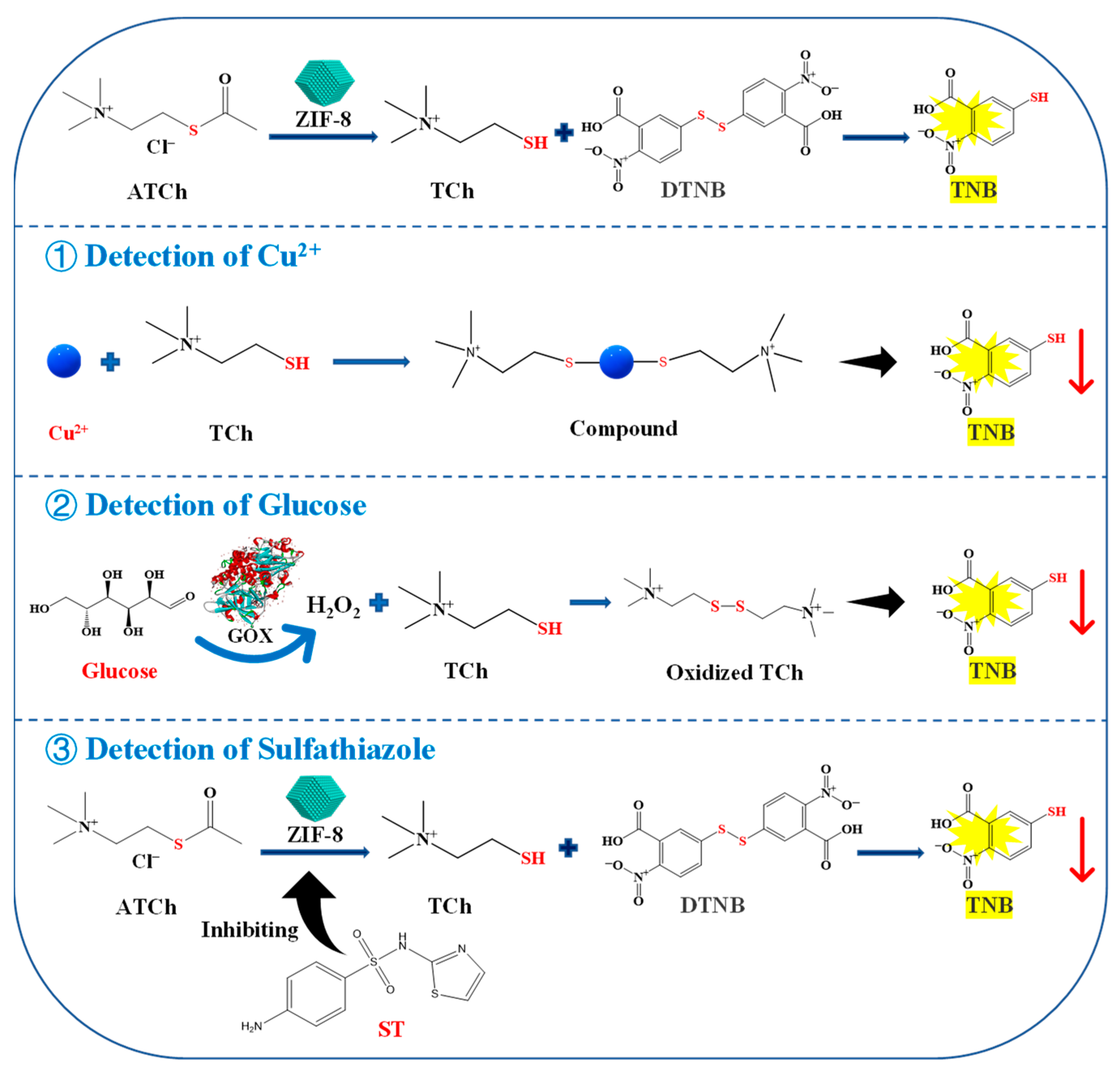
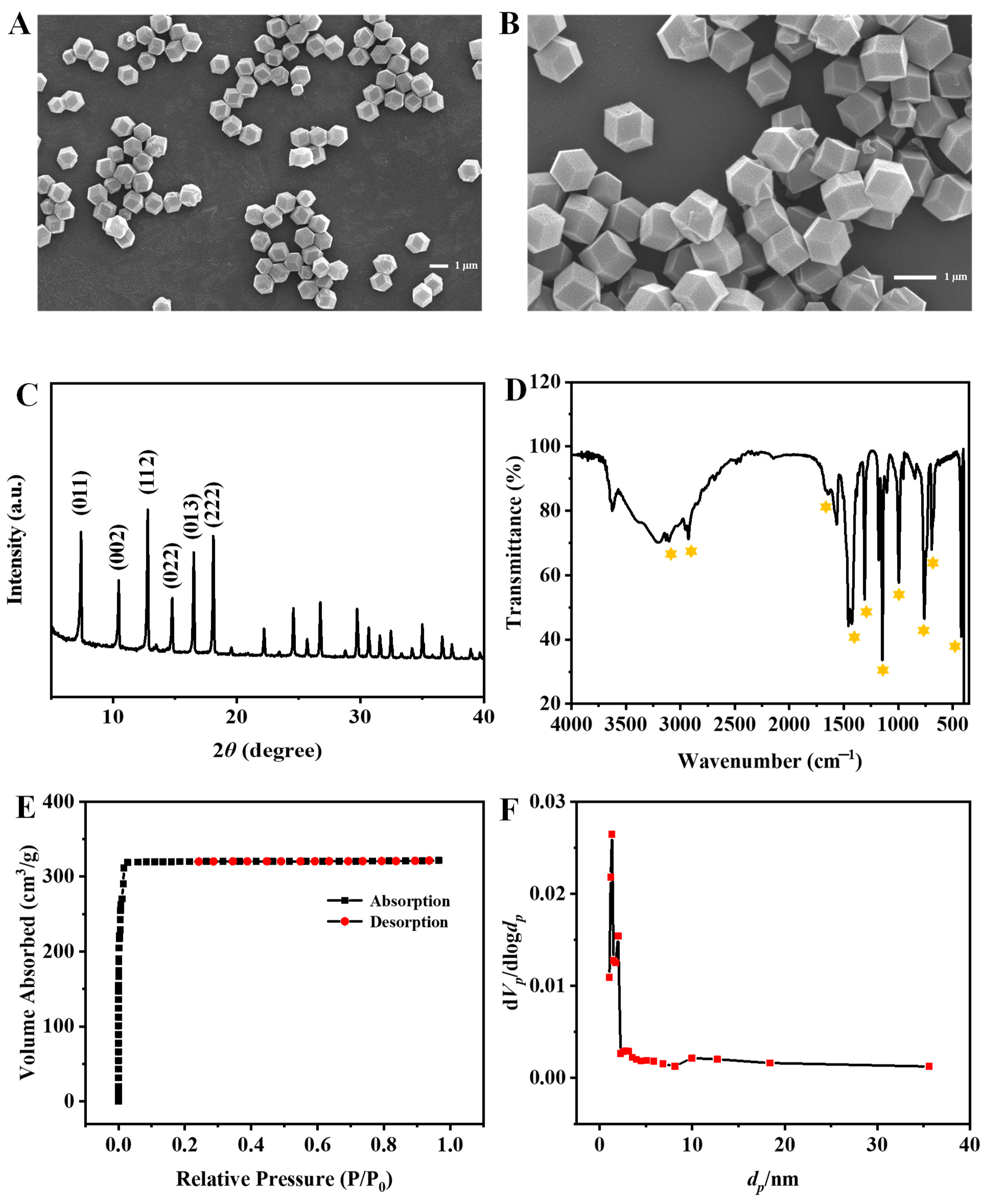
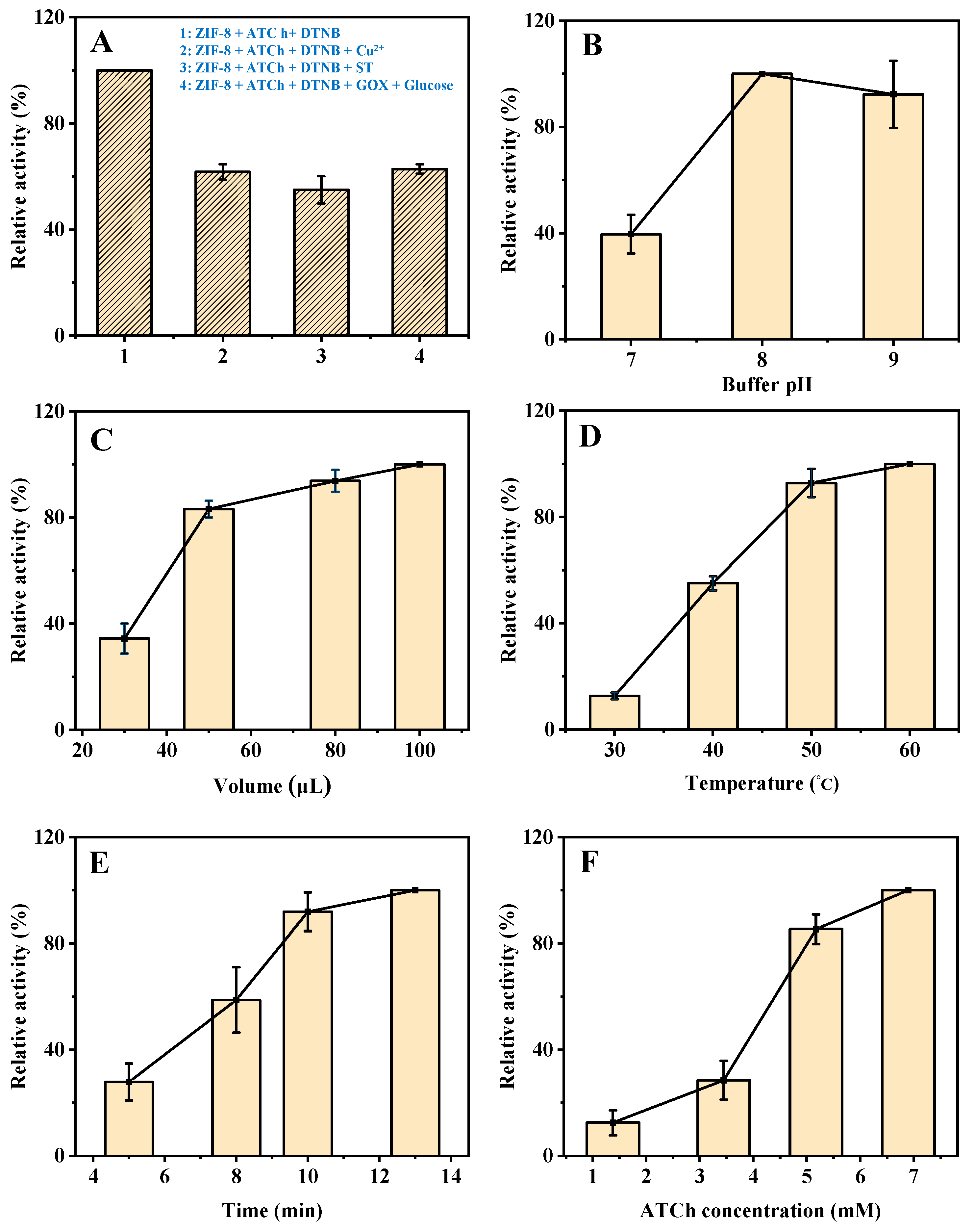
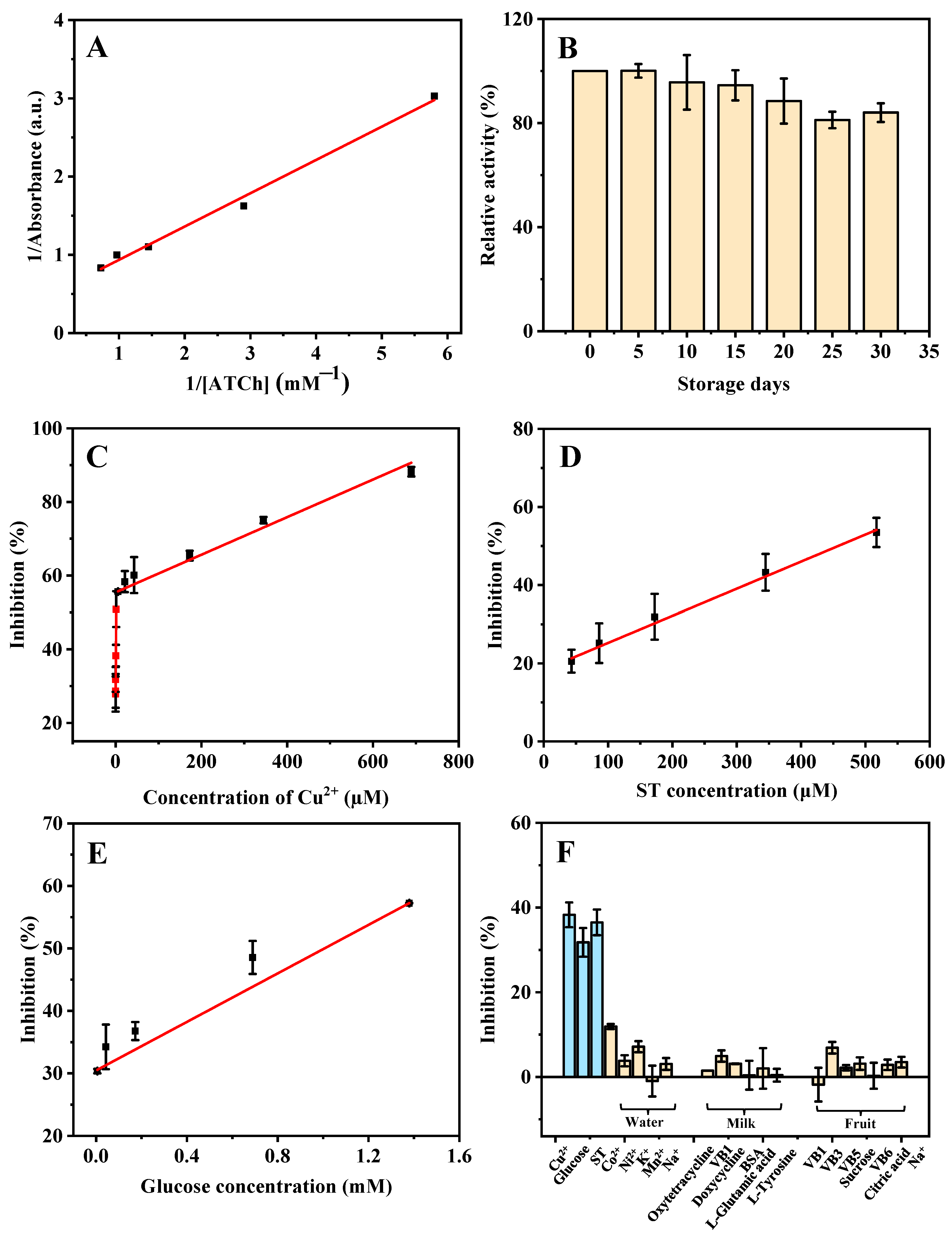
| Material | Detection Method | Material Synthesis Process | Reaction Time (min) | Linear Range (µM) | LOD (µM) | Ref. |
|---|---|---|---|---|---|---|
| Ag/Zn-ZIF-8 | Fluorescence | Synthesized at room temperature for 20 h–24 h; dried overnight in a vacuum oven at 80 °C | 30 | 1–20 | 6.7 | [21] |
| ZnO-Co3O4 | Colorimetry | Synthesized at room temperature for 24 h; dried in vacuum at 60 °C for 12 h; heated at 350 °C for 3 h | 10 | 2–100 | 1.1 | [22] |
| 5-chlorosalicylaldehyde fluorescein hydrazone (CSFH) | Colorimetry | Refluxed for 8 h under constant stirring | 0.17 | 0.25–14 | 0.3 | [23] |
| 1-Phenyl-3-methyl-5-hydroxypyrazole-4-benzoyl (fluorescein) hydrazone | Colorimetry | Settle for 2 h; refluxed for 8 h with stirring | 2 | 2–40 | 2 | [24] |
| Au NPs | Colorimetry | Heated to boiling under vigorous stirring; heated for an additional 30 min | 10 | 0.1–1.2 | 0.05 | [25] |
| h-CD | Fluorescence | Heated to 180 °C and kept for 12 h; dialyzed with a dialysis membrane (molecular weight of 7000 Da) for 12 h | 720 | 0–10 | 0.2 | [26] |
| P(DO-a-DTODT)-g-BTDX | Colorimetry | Stirred continuously for 12 h | - | 0–10 | 0.03 | [27] |
| Pt/Co3O4 | Colorimetry | Synthesized at 160 °C for 1 h; dried in vacuum at 50 °C for 12 h; calcined in a muffle furnace at 450 °C for 4 h; synthesized at 90 °C for 20 min under constant stirring | 15 | 10–200 | 4.1 | [28] |
| ZIF-8 (AChE) | Colorimetry | Synthesized at 30 °C for 2 h | 10 | 0.021–1.34; 5.38–689.66 | 0.020 | This work |
| Material | Detection Method | Material Synthesis Process | Reaction Time (min) | Linear Range (U/L) | LOD (U/L) | Ref. |
|---|---|---|---|---|---|---|
| μPAD-microfluidic paper | Colorimetry | Heated for 2 min at a temperature of 150 °C | 15 | 2.5–40 | 2.5 | [29] |
| AuNPs | Surface-enhanced Raman spectroscopy | Keep boiling and stirring for 30 min | 0.17 | 2.0–78.3 | 3.9 | [30] |
| Cu NCs | SPME-Fluorescence | Refluxed for 15 h; degassed by nitrogen for 30 min and then heated at 70 °C for 24 h | 55 | 0.5–99.9 | 0.3 | [31] |
| - | HPLC- Fluorescence | - | 100 | 29.4–1175.0 | 9.8 | [32] |
| MIP/CuS/Au@COF/GCE | Electrochemistry | Heated for 10 h at 120 °C; stirred for 12 h at room temperature | - | 1.0–108 | 4.3 | [33] |
| MIP/MCL | Chemiluminescence | Stirred for 5 min and kept at 4 °C overnight; stirred in a 65 °C water bath for 24 h; extracted with methanol/acetic acid for successive 72 h | 20 | 3.9–47.0 | 3.9 | [34] |
| ZIF-8 (AChE) | Colorimetry | Synthesized at 30 °C for 2 h | 10 | 43.10–517.24 | 9.25 | This work |
| Material | Detection Method | Material Synthesis Process | Reaction Time (min) | Linear Range (mM) | LOD (µM) | Ref. |
|---|---|---|---|---|---|---|
| AgNC-GOx/Ag+-FP | Fluorescence | Synthesized at 150 °C for 20 min | 120 | 0.050–5 | 50.0 | [35] |
| g-C3N4 | Electrochemistry | Calcined at 550 °C for 2 h; heated at 500 °C for 2 h | - | 0.050–2 | 5.0 | [36] |
| ZnONT | Electrochemistry | Synthesized at 85 °C for 1.9 h; kept at 85 °C for 1.5 h | - | 0.050–12 | 1.0 | [37] |
| GOx@CPB | Colorimetry | Synthesized at 60 °C for 5 min | 1 | 0.0005–0.1 | 0.5 | [38] |
| Co-MOFs | Electrochemistry | Synthesized at 100 °C for 72 h | - | 0.010–1.2 | 3.2 | [39] |
| ZIF-67/rGO/CF | Electrochemistry | Treated at 300 °C for 30 min; kept at room temperature for 4 h | - | 0.001–1 | 0.2 | [40] |
| ZIF-8 (AChE) | Colorimetry | Synthesized at 30 °C for 2 h | 10 | 0.0054–1.40 | 5.24 | This work |
| Substance | Sample | Added (µM) | Founded (µM) | Recovery (%) | RSD (n = 3, %) |
|---|---|---|---|---|---|
| Cu2+ | YUN lake | 0.084 | 0.098 | 116.7 | 1.5 |
| 21.55 | 23.22 | 107.7 | 3.4 | ||
| 172.41 | 192.27 | 111.5 | 2.7 | ||
| JIN lake | 0.084 | 0.075 | 89.3 | 1.5 | |
| 21.55 | 17.68 | 82.0 | 8.1 | ||
| 172.41 | 183.19 | 106.3 | 6.1 | ||
| ST | Milk (Tianyou) | 43.10 | 42.41 | 98.4 | 1.8 |
| 86.20 | 99.47 | 115.4 | 3.3 | ||
| 172.41 | 196.89 | 114.2 | 1.9 | ||
| Glucose | Strawberry | 0 | 0.95 | - | 2.8 |
| 0.086 | 1.03 | 93.0 | 0.9 | ||
| 0.17 | 1.12 | 100.0 | 1.8 | ||
| 0.34 | 1.33 | 111.8 | 1.2 |
Publisher’s Note: MDPI stays neutral with regard to jurisdictional claims in published maps and institutional affiliations. |
© 2022 by the authors. Licensee MDPI, Basel, Switzerland. This article is an open access article distributed under the terms and conditions of the Creative Commons Attribution (CC BY) license (https://creativecommons.org/licenses/by/4.0/).
Share and Cite
Chen, G.-Y.; Qian, Z.-M.; Yin, S.-J.; Zhou, X.; Yang, F.-Q. A Sensitive and Selective Colorimetric Method Based on the Acetylcholinesterase-like Activity of Zeolitic Imidazolate Framework-8 and Its Applications. Molecules 2022, 27, 7491. https://doi.org/10.3390/molecules27217491
Chen G-Y, Qian Z-M, Yin S-J, Zhou X, Yang F-Q. A Sensitive and Selective Colorimetric Method Based on the Acetylcholinesterase-like Activity of Zeolitic Imidazolate Framework-8 and Its Applications. Molecules. 2022; 27(21):7491. https://doi.org/10.3390/molecules27217491
Chicago/Turabian StyleChen, Guo-Ying, Zheng-Ming Qian, Shi-Jun Yin, Xi Zhou, and Feng-Qing Yang. 2022. "A Sensitive and Selective Colorimetric Method Based on the Acetylcholinesterase-like Activity of Zeolitic Imidazolate Framework-8 and Its Applications" Molecules 27, no. 21: 7491. https://doi.org/10.3390/molecules27217491
APA StyleChen, G.-Y., Qian, Z.-M., Yin, S.-J., Zhou, X., & Yang, F.-Q. (2022). A Sensitive and Selective Colorimetric Method Based on the Acetylcholinesterase-like Activity of Zeolitic Imidazolate Framework-8 and Its Applications. Molecules, 27(21), 7491. https://doi.org/10.3390/molecules27217491







